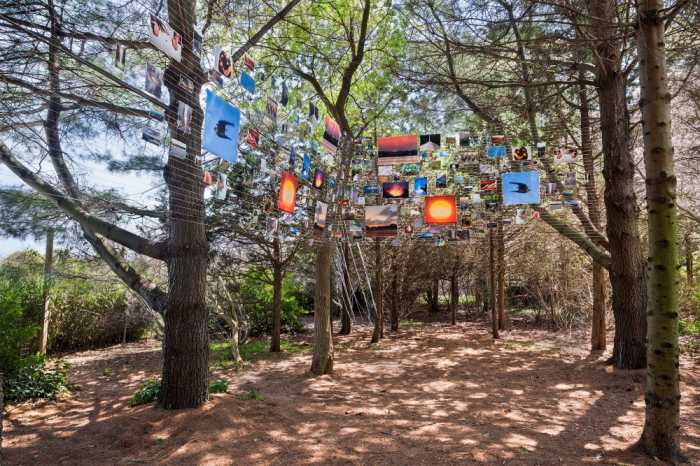Honoring The Artist: Ty Stroudsburg

Paintings by cover artist Ty Stroudsburg always put the viewer “in the picture,” so to speak. It’s as if we were literally there, walking through the fields and meadows, feeling the flowers press against our legs, smelling the fragrances. Stroudsburg is one of those special artists who engages our senses on every level. Moreover, her arresting use of diverse dimensions adds to our well being. The term “dimensions” is an important one, suggesting the artist’s composition, where diagonals, horizontals and verticals combine to make a stunning image. Works like “Peach Orchard Spring” and “Mums- The South Field” certainly make the point, as does this week’s cover, “Red Garden at Long House.”
Q: When did you paint the cover image? I don’t remember that garden at Long House, but I hope it’s still there.
A: I did it in 2004; I had intended to paint the pond for a show at Guild Hall. I got there late and painted the garden instead.
Q: Your colors are so extraordinary in this image and in all your works. How do you find them?
A: I drive around looking for colors. For example, a year ago I looked in my side view mirror and saw an orange color from plantings that New York State had done at the side of the road. They were Black Eyed Susans.
Q: Where are your favorite places to find colors that really attract you?
A: Pennsylvania and the Adirondacks. I don’t go far.
Q: Besides the colors, how would you describe your paintings?
A: Abstract images in the foreground. I also push my horizon line to the top. It’s Abstract Expressionism.
Q: How did you end up on the North Fork in the first place?
A: I moved out here accidently. A relative had moved here, and I was going to paint the inside of her house. I moved here in 1985. I discovered the Parrish Museum and Guild Hall and met Mary Abbot and Fairfield Porter.
Q: How about your art training? Were you an artist when you moved here?
A: I grew up in northern New Jersey and majored in art. I was going to teach art, but the program focused on child development, what children should be painting at certain ages. The major did not encourage teachers to paint themselves.
Q: Obviously, you decided not to become an art teacher. Did your parents encourage you to become an artist?
A: My father encouraged me to paint and I remember his taking me to the paint store.
Q: At the time, being an artist wasn’t a good career for a woman. Anyone else in your family who was an artist?
A: I was adopted and was the only child. When I was 40, I found my siblings and met all of them. Some were musical and some were artists.
Q: I believe artistic talent is inherited.
A: I do, too.
Q: Do you travel much, looking for those special colors?
A: I’m a homebody. I have no desire to travel. People are always saying I should go to Tuscany. But as long as I can go out and come back to my studio, I’m happy. I like to keep it simple.
Q: When not painting, what do you do?
A: I walk with my English sheep dog. It’s a rescue dog, the fourth one I’ve had. I also play the classical guitar and like target shooting. I ride horses, too.
Q: What a great variety. How would you describe your paintings, not technically speaking, but philosophically-speaking?
A: It’s not looking at the scenery, but looking in the scenery, experiencing the movement, the color. If I don’t paint, I won’t exist.
Ty Stroudsburg’s works can be seen at the Long Island Museum- Stonybrook from April 12 to July 8. Call 631-751-0066 for information. Contact the artist at: www.tystroudsburg.com
The cover image is courtesy of Spanierman Gallery, New York.










